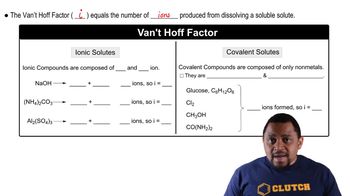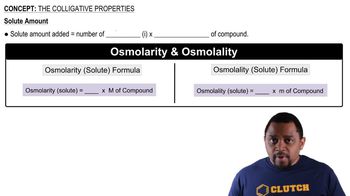Here are the essential concepts you must grasp in order to answer the question correctly.
Van't Hoff Factor (i)
The Van't Hoff factor (i) represents the number of particles into which a solute dissociates in solution. For ionic compounds like KCl, which dissociates into K+ and Cl- ions, the factor indicates how many particles contribute to colligative properties, such as boiling point elevation. In this case, KCl has a Van't Hoff factor of 1.85, suggesting it does not fully dissociate into two particles due to ion pairing or other interactions.
Recommended video:
Colligative Properties
Colligative properties are physical properties of solutions that depend on the number of solute particles in a given amount of solvent, rather than the identity of the solute. These properties include boiling point elevation, freezing point depression, vapor pressure lowering, and osmotic pressure. The boiling point elevation can be calculated using the formula ΔT_b = i * K_b * m, where ΔT_b is the change in boiling point, K_b is the ebullioscopic constant, and m is the molality of the solution.
Recommended video:
Boiling Point Elevation
Boiling point elevation is a colligative property that describes the increase in the boiling point of a solvent when a solute is dissolved in it. The extent of this elevation is directly proportional to the molality of the solution and the Van't Hoff factor. For water, the boiling point can be calculated using the formula T_b = T_b0 + ΔT_b, where T_b0 is the boiling point of pure solvent, and ΔT_b is determined from the product of the Van't Hoff factor, the ebullioscopic constant, and the molality of the solution.
Recommended video:




